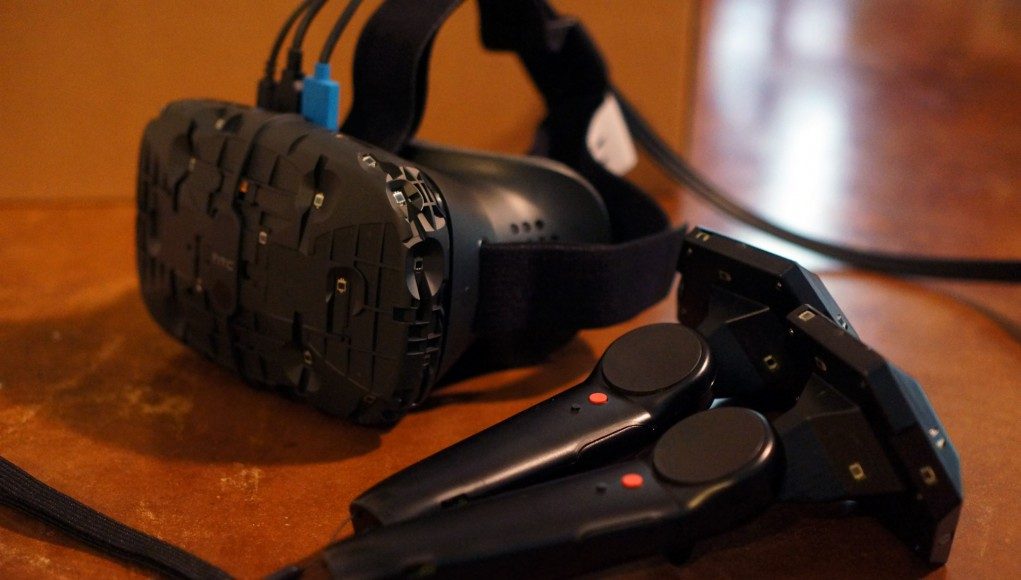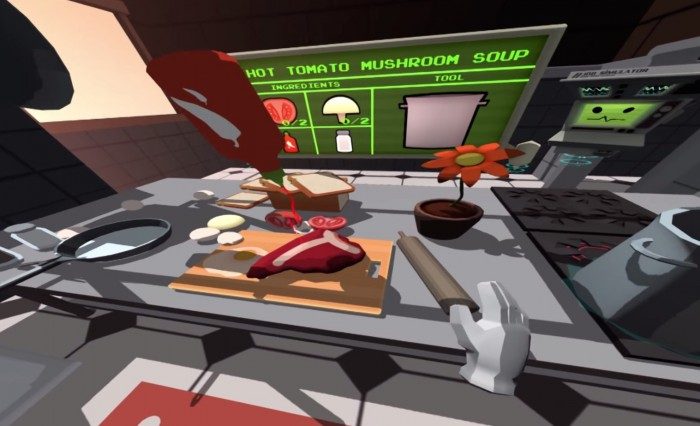CES is mere days away and as we edge into 2016, we take a look back at the surprise entry and stratospheric rise of the HTC Vive, Valve’s SteamVR flagship virtual reality hardware and, what we might expect to see at 2016.
One of the most exciting things about the VR space, is that it moves at a bewildering pace (rhyme unintended). So, despite writing about virtual reality day in, day out, I still had to double check the fact that Valve’s entrance to the consumer VR race happened less than a year ago.
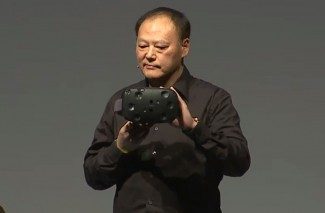
The HTC Vive debuted at the Mobile World Congress in Barcelona just prior to the 2015 Game Developer Conference in March. At the show, HTC proudly announced that they had entered into a partnership with gaming giant Valve, to bring their desktop VR technology to life in a new product called the Vive.
Initial confusion over the name (reVive / Vive?) notwithstanding, the announcement caused a pretty major stir in the VR community and beyond. What the hell was a mobile phone manufacturer doing in the desktop VR space? What were these new SteamVR input devices and how on earth did they work? What happened to Valve and Oculus’ initially tight relationship – one that had been so fruitful in the past?
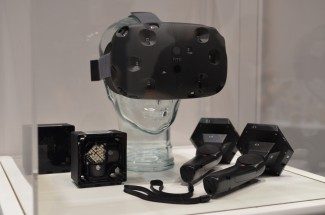
Most of these questions were answered the following week, when SteamVR and the HTC Vive took GDC 2015 by storm. At the show we learned that the headset itself was pretty similar in fundamental design to the latest Oculus Rift prototypes, with dual 1200×1080 OLED panels running at 90Hz. But there was one major differentiator that helped the Vive stand apart from Oculus’ offering – lasers.
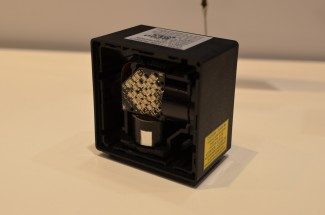
Lighthouse, it was revealed, was a tracking system unlike any we’d seen before and was at the heart of the SteamVR’s experience. Using one or more laser basestations which scanned the play-space at a defined frequency, sweeping the room vertically and horizontally as it did so.
See Also: 10 Things You Didn’t Know About Steam VR’s Lighthouse Tracking System
Lighthouse compatible headsets and peripherals picked up the pulses of light via photo-sensitive diodes. The timing of these pulses, when fed back to the PC rendering the show and extrapolated, allows a SteamVR application to accurately detect position and movement in 3D space. Two basestations will happily cover a 15ft x 15ft play-space, allowing freedom of movement within this space for the VR user to walk, crawl or do anything else they wish (within reason). Although it should be noted that the system will scale down as well as up, with a single basestation sufficient for a seated experience.
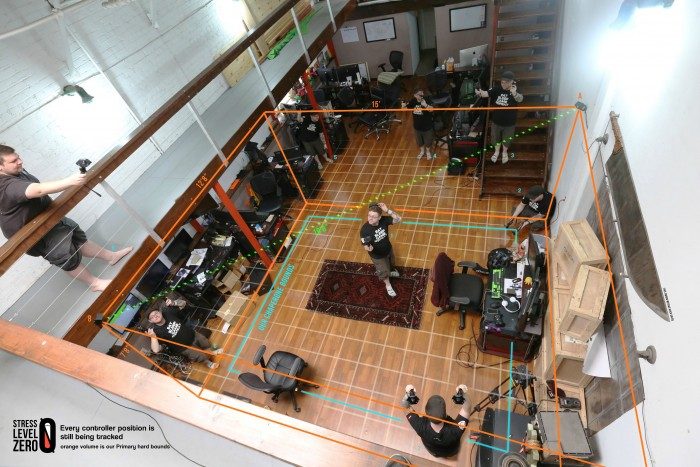
The technology gave rise to a new (as it turns out potentially unhelpful) VR buzzphrase, “room-scale VR” – seemingly the more liberal cousin to Oculus’ “seated experience”. The SteamVR controllers too seemed to be a major component in enhancing user immersion. Tracked incredibly precisely, the physical controllers represented in VR moving so accurately seemed to aid in feeling of presence felt by users. They also allowed intuitive control over virtual objects and space – something we’d not yet seen.
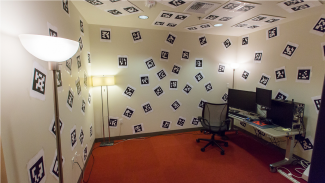
This room-scale experience had been seen before, with those lucky enough to try Valve’s earlier prototype VR hardware, using wall mounted fiducial markers, at Steam Dev Days in 2014, noting similar levels of immersion and virtual reality freedom. At that time, Valve was still seemingly close with Oculus, collaborating on breakthrough techniques such as low persistence of vision OLED panels (initially incorporated into the Crystal Cove feature prototype shown by Oculus at CES 2014). At some point between CES and Oculus’ acquisition by Facebook, that relationship appeared to change – although precisely why remains a mystery.
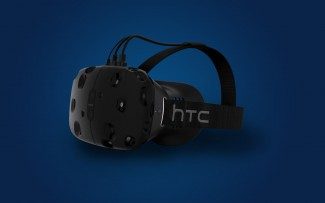
This freedom of movement was the key to why the Vive and SteamVR controllers captured imaginations so effectively at GDC. We’d already seen the powerful, presence-enhancing applications of a standing VR experience. Oculus had already, very successfully demonstrated this with their excellent Crescent Bay prototype demo set at Oculus Connect in September 2014 (and later at CES 2015). The ability to move freely around a virtual space meant that, despite the visual components in the Vive prototype being analogous to the Rift, people’s impressions when they tried Vive prompted many familiar with the Rift experience to declare the demo’s shown at GDC by Valve to be the best VR experience they’d had so far.

The demos shown by Valve at GDC included a brand new in-house, created-for-VR experience set in the Portal universe known as Aperture Science Robot Repair. The demo walks the player through a set of experiences designed to showcase the new SteamVR controllers, culminating with a face-to-face (or in your face depending where you were standing) with GladOS. WEVR’s theBlu:Encounter placed the user underwater aboard a sunken shipwreck and face to face with a giant blue whale. Skillman & Hackett’s Tilt Brush allowed the user to get creative, painting in three dimensions. Those who were lucky enough to try them, shared experiences that seemed almost universally positive.
After GDC, this theme continued throughout 2015, as HTC went on a PR offensive, rolling out the technology via a demonstration tour that would take the Vive and SteamVR around the world.
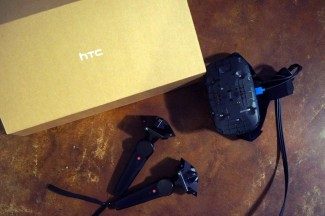
HTC Vive development kits (‘Developer Editions’) were offered up in April with kits eventually shipping in June. The precise number of just how many developer editions actually shipped is unknown, but as 2015 came to a close it seemed as if almost every developer who wanted one, had one and had started on Vive versions of their projects or inspired by the perceived new found freedom afforded by Lighthouse tracking, entirely new ones.
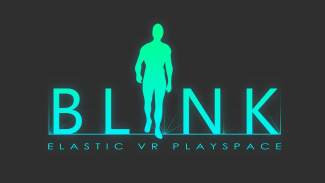 Cloudhead Games, who’s The Gallery: Six Elements had an ambitious vision for VR exploration, announced that SteamVR and the HTC Vive gave them a “hardware target that matches the original vision for The Gallery: Six Elements. To unleash the user into full, volumetric, 360 room-scale experiences with motion control!”. They too demo’d at GDC and later would develop a locomotion system entitled ‘Blink’ which works around problems inherent in room-scale VR.
Cloudhead Games, who’s The Gallery: Six Elements had an ambitious vision for VR exploration, announced that SteamVR and the HTC Vive gave them a “hardware target that matches the original vision for The Gallery: Six Elements. To unleash the user into full, volumetric, 360 room-scale experiences with motion control!”. They too demo’d at GDC and later would develop a locomotion system entitled ‘Blink’ which works around problems inherent in room-scale VR.
Owlchemy Labs who were, along with Cloudhead and WEVR, amongst others, chosen to receive early Valve VR prototypes to developer demos for GDC. Job Simulator was built on the strength of SteamVR’s controllers, and the inherent fun of messing about in a virtual space when input is removed as a barrier.
Other notable titles to appear throughout 2015 built for the HTC Vive were Nimbus Knights from Otherworld Interactive, Final Approach from Phaser Lock Interactive, Elite: Dangerous from Frontier, Fantastic Contraption from Radial Games and Northway Games to name just a few.
HTC’s original announcement included an enticing release target for the consumer edition of the Vive hardware. The kit would be out to buy before the close of 2015 it was stated. This would later slip however, initially moving to a limited number shipped in 2015 – but eventually being bumped to Q2 2016 – with pre-orders opening in February.
HTC eventually claimed that the reason for the slip was to incorporate a “very, very big breakthrough”. Later it was revealed that this breakthrough would be incorporated into a new developer edition dev kit, and would be shown at CES 2016.
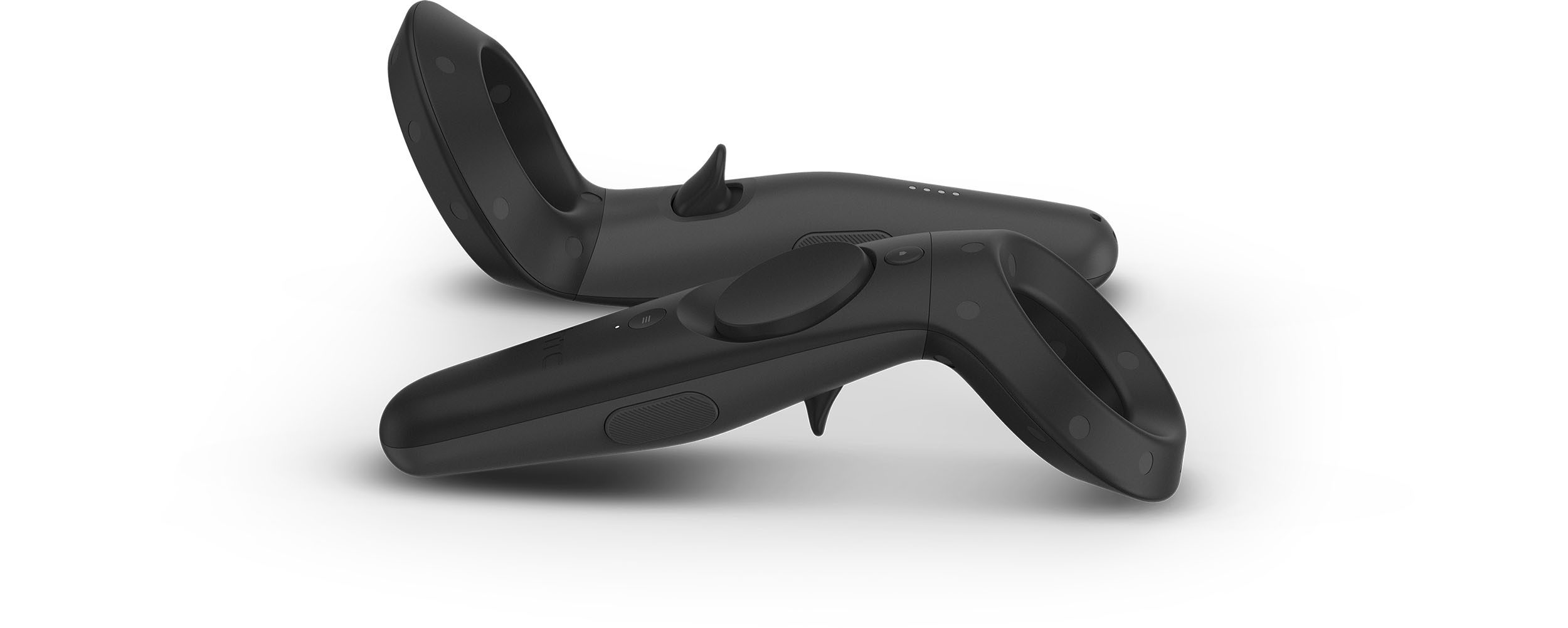
Leaked images, seemingly showing what the new developer edition HTC Vive hardware would look like, made their way onto the Internet recently too – giving us a glimpse at what to expect from hardware on show at CES 2016. The new, more attractive, more refined designs certainly look close to what would be expected from a retail product.
The latter half of 2015 was not kind to HTC however. It transpired that the firm was facing significant financial difficulties with the failure of its more recent mobile phone offerings and competitor market share to blame. HTC it seems are now looking to 2016 and virtual reality to revive (no pun intended) its fortunes going forward. Whilst the gamble seems risky, their partnership with Valve has resulted in VR hardware everyone wants to get their hands on and the team now represent Oculus’ only major competitor in the desktop VR space as we head into 2016. That gamble may just pay off.
HTC, Valve and the Vive at CES 2016
Mystery shrouds the “very, very big breakthrough” hinted at by HTC’s CEO recently, but whatever it is, we’ll find out in detail as the new developer edition HTC Vives are present at CES 2016. Is the breakthrough an enhancement to the Lighthouse tracking system? Enhanced display or optics? We simply don’t know yet I’m afraid, but within days we will.
Valve’s Chet Faliszek, a writer turned VR evangelist, recently tweeted that Valve will be present at CES 2016, in sharp contrast to last year’s secretive presence.
Last year at CES we were just quietly meeting with people and checking things out while we kept our secret.This one will be a bit different.
— Chet Faliszek (@chetfaliszek) January 2, 2016
Meanwhile, a company known for 3D modelling software for hardware design, has tweeted that they’re demonstrating a partnership with HTC on their “next generation” VR systems – presumably the new developer edition.
We are excited to partner with @HTCVive to showcase their next generation #VR system at @CES. #CES2016 pic.twitter.com/kF53a0eCwn
— Dassault Systèmes (@Dassault3DS) January 3, 2016
Aside from meeting with HTC themselves, we’re also scheduled to try the new Vive hardware in conjunction with Audi, who are planning to roll the technology out to showrooms around the world, apparently to aid the car demonstration and customisation process to customers.
We have it on good authority that Virtuix will have the latest HTC Vive developer edition on their Omni booth at CES, and it seems likely that partners developing with the Vive listed on HTC’s recent blog post will also be wielding the latest hardware.
We’ll be witnessing some new content too. Alienware has a VR experience called The Lonely Whale, developed by Adrian Grenier, which will be demonstrated powered by their PC hardware on the show floor.
Fox will be demonstrating the live-rendered version of The Martian VR experience, a sneak peak of which was released for Gear VR just recently.
- VirZOOM will be showcasing their VirZOOM bike VR experience.
- Alienware will be featuring their original content “The Lonely Whale” created with Adrien Grenier.
- Intel is hosting live Vive performances in their show floor booth and LVCC Lobby.
- Fox will be demoing their experience ‘The Martian’ based on the blockbuster movie.
- AMD, CyberPowerPC, Envelop VR, EVGA, HP, HyperX, iBuyPowerPC, MSI, Nidec, Nvidia, and Zotac will also be showing content on the Vive.
So it seems HTC and Valve are pulling out all the stops to get people inside their VR hardware this CES. Once again, hard to believe just one year ago, the entire project was yet to be announced.
In Summary
Valve and HTC’s appearance as competitors to Oculus in the desktop VR space is timely and incredibly welcome. For consumers, it gives them options on how they’d like to enter the world of VR. The Vive and SteamVR controllers offer an elegant, scalable tracking system which arguably offer more simple flexibility than Oculus’ single camera outside-in tracking system (you can of course add more tracking cameras, with each one attached to the computer, but it’s not clear how well this is officially supported and running USB cables around a typical room may present problems). A tweet from Oculus founder Palmer Luckey recently highlighted this as possible.
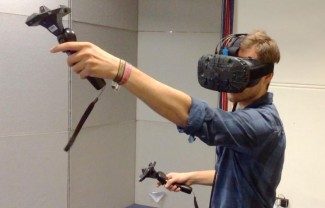 It’ll be interesting to see what percentage of users manage to achieve the 15x15ft play-space used in many of the HTC Vive demos – the Vive’s current key differentiator. Space is at a premium in many modern homes (especially in space constrained space like the UK), and without a room to dedicate to VR (or at least one that be adapted when needed), it may be challenging to realise that potential.
It’ll be interesting to see what percentage of users manage to achieve the 15x15ft play-space used in many of the HTC Vive demos – the Vive’s current key differentiator. Space is at a premium in many modern homes (especially in space constrained space like the UK), and without a room to dedicate to VR (or at least one that be adapted when needed), it may be challenging to realise that potential.
That said, the Vive will ship with the best VR input devices available at launch (assuming the April 2016 target is met) in the box, with games developed since inception with those in mind – a significant advantage. That is until the recently delayed Oculus’ Touch arrived in the 2nd half of 2016.
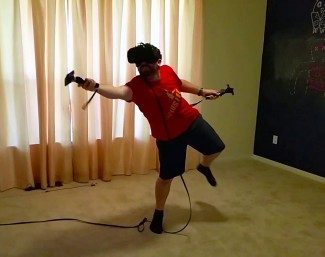 Speculation is that the HTC Vive may occupy the ‘premium’ portion of the VR headset market (in truth, we have no indications on price as yet), with hardware in the retail box likely to include a Vive VR headset, two SteamVR controllers and two lighthouse laser basestations, it’s a more expensive proposition from a production perspective, without considering bundled software. With Valve pushing developer kits to so many developers so quickly and their long (and distinguished) history in game development, you’d be a fool to bet against them finding games to make that premium worthwhile.
Speculation is that the HTC Vive may occupy the ‘premium’ portion of the VR headset market (in truth, we have no indications on price as yet), with hardware in the retail box likely to include a Vive VR headset, two SteamVR controllers and two lighthouse laser basestations, it’s a more expensive proposition from a production perspective, without considering bundled software. With Valve pushing developer kits to so many developers so quickly and their long (and distinguished) history in game development, you’d be a fool to bet against them finding games to make that premium worthwhile.
We’re looking forward to learning more about HTC and Valve’s plans for SteamVR in 2016 as we cover CES from the show floor all week. Stay tuned for all the news on Road to VR.

